Advisory Board

David Cliffel, Ph.D.
Professor of Chemistry
Ph.D., University of Texas, 1998
VINSE, VICB, Nanoparticle Biomimics, Electroanalytical Chemistry, Chemical Biology, Bioanalytical Chemistry and Analytical Chemistry
Associate professor of chemistry David Cliffel can be a challenge. In addition to teaching, the expert in electrochemistry and analytical chemistry oversees research in six labs in four buildings within the Stevenson Center. This lab on the fifth floor of Building 5 serves as home base for the Cliffel Research Group, his team of post-doctoral associates, graduate students and undergraduates. The group works with specialized instrumentation and processes unfamiliar to most, but its research may one day impact diabetes, vaccines and cancer.
http://www.vanderbilt.edu/AnS/Chemistry/groups/cliffel/

F. Peter Guengerich, Ph.D.
Professor of Biochemistry
Ph.D., Vanderbilt University, 1973 (Biochemistry)
Major areas of interest include the metabolism of carcinogens and drugs by cytochrome P450 enzymes, the bioactivation of halogenated hydrocarbons, and polymerase interactions with carcinogen-modified DNA. Several approaches are being used to understand the catalytic mechanisms of the human cytochrome P450 enzymes, including site-directed mutagenesis, kinetic analysis, isotope effects, and substrate-activity relationships. One major area of interest is the identification of reactions catalyzed by the “orphan” P450s, those in humans and also Streptomyces that do not have characterized functions yet. Work on halogenated hydrocarbons is done with trichloroethylene, ethylene dibromide, and methylene dihalides and the adducts they form. Glutathione transferase-mediated bioactivation is under investigation, as well as in the case of some bifunctional electrophiles. Studies on the polymerases involve the use of modified oligonucleotides, steady-state and pre-steady-state kinetics, and physical approaches such as x-ray diffraction. A major goal is to understand how carcinogen-DNA adducts cause polymerases to stall and misincorporate bases.
https://my.vanderbilt.edu/guengerichlab/

Kevin Osteen, Ph.D.
Pierre Soupart Professor of Obstetrics and Gynecology
Director, Womens’s Reproductive Health and Research Center
Adjunct Professor of Obstetrics and Gynecology at Meharry Medical College
My research laboratory has focused on the endometrium as a model to identify interrelationships between steroid action and stromal-epithelial cell communication via specific paracrine factors. Of special interest to us are the cellular and molecular mechanisms which control steroid-dependent versus steroid-independent expressions of metalloproteinases. These enzymes are necessary for degradation of extracellular matrix proteins and play important roles in the extensive tissue remodeling which normally occurs during the menstrual cycle as well as during establishment of the hemochorial placenta. Metalloproteinases may also contribute to the pathophysiology of endometrial dysfunction including abnormal bleeding, defects of placentation and the extrauterine disease endometriosis. Recently, we have extended our studies to investigate altered metalloproteinase gene and protein expression relative to the reproductive toxicology of dioxin.
http://www.vicc.org/dd/display.php?person=kevin.osteen
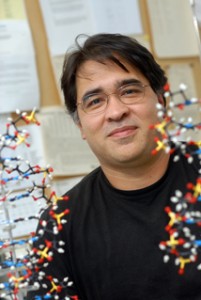
Carmelo J. Rizzo, Ph.D.
Professor of Chemistry and Biochemistry
Ph.D., University of Pennsylvania, 1990 (Organic Chemistry)
Covalent modification of DNA by electrophiles is the initial step in chemical carcinogenesis. If these modifications are not repaired, they compromise the fidelity of DNA replication leading to mutations and possibly cancer. To properly study the mutagenic effects and repair of these lesions, oligonucleotides containing structurally defined carcinogen adducts are required. Versatile synthetic strategies are currently being developed for the synthesis of oligonucleotides, which are site-specifically modified by carcinogens. The main focus is on two classes of DNA-carcinogen adducts. The first is C8-deoxyguanosine adducts of aryl amines such as IQ, which is found in cooked meats. 1,N2-deoxyguanosine adducts of lipid peroxidation products, such as 4-hydroxynonenal, are also being synthesized. Once synthesized, structural and biological analyses of the modified oligonucleotides are carried out in collaboration with other research groups. In the case of DNA adducts of lipid peroxidation products, the role of the adduct stereochemistry on the chemistry and biology of the modified DNA is of particular interest.
http://as.vanderbilt.edu/chemistry/Rizzo/Group/Group.html
T32 Preceptors

Mariana X. Byndloss, Ph.D.
Assistant Professor of Pathology, Microbiology and Immunology
In high-income countries, the leading causes of death are non-communicable diseases, such as Bowel Disease (IBD), obesity, cancer and cardiovascular disease. An important feature of most non-communicable diseases is exposure to environmental insults that cause inflammation-induced gut dysbiosis characterized by a shift in the microbial community structure from obligate to facultative anaerobes such as Proteobacteria. This microbial imbalance can contribute to disease pathogenesis due to either a microbiota-derived metabolite being depleted or produced at a harmful concentration. However, little is known about the mechanism by which inflammation mediates changes in the host physiology to induce disruption of the microbial ecosystem in our large intestine leading to disease. Therefore, our group uses a multidisciplinary approach combining microbiology, molecular biology, cell biology, immunology and pathology to try to understand how inflammation-dependent changes in gut epithelial metabolism can result in gut dysbiosis and increased risk to non- communicable disease. Specifically, we used a variety of mouse models, including diet-induced-obesity, chemical-induced colitis, infectious gastroenteritis (Salmonella enterica serovar Typhimurium), and germ-free animals with the goal to identify metabolic pathways in the gut bacteria and in the host response to microbiota-induced metabolites that will aid in prevention of human disease.

Richard M. Caprioli, Ph.D.
Stanley Cohen Professor of Biochemistry, Chemistry, and Pharmacology
Director of the Mass Spectrometry Research Center
Ph.D., Columbia University, 1969 (Biochemistry)
The research interests of this laboratory are aimed at the investigation of biological processes involving the synthesis, modification, biological activity, storage, and degradation of peptides and proteins using modern mass spectrometric methods of analysis to follow molecular events. In recent years, the focus of the work has been the study of disease processes and the biochemical events involved in the metabolism of peptides (primarily in the brain and gut of mammals), encompassing the enzymatic breakdown of these peptides, their production from peptide and protein precursors, and the disruption of these processes by xenobiotics. Modern mass spectrometry technology, including liquid chromatography/electrospray/ tandem mass spectrometry (LC/ESI/MS/MS) and matrix-assisted laser desorption ionization (MALDI) mass spectrometry are key technologies used for discovery and identification of proteins in both normal and diseased or compromised tissue. Special emphasis is placed on mass spectrometry imaging technology, a new method that involves molecular mapping of tissue through the production of ion images obtained from the analysis of mammalian tissue slices by MALDI mass spectrometry. These data can then be correlated with clinical outcomes and serve as diagnostic and prognostic indicators.
http://www.mc.vanderbilt.edu/root/vumc.php?site=msrc

Walter J. Chazin, Ph.D.
Chancellor’s Chair in Medicine
Professor of Biochemistry and Chemistry
Director of the Center for Structural Biology and Vanderbilt NMR Center
Ph.D., Concordia University, Montréal, Canada, 1983 (Physical Chemistry)
A major interest in this laboratory is the repair of damaged DNA. The goal is to understand the biochemical and structural mechanisms of the large multi-protein DNA replication, damage response, and repair machines. Initial efforts have focused on complexes built around replication protein A (RPA), an essential factor that protects and organizes single strand DNA as well as coordinates the assembly of protein complexes in virtually all DNA processing machinery. An area of current emphasis is the recognition and processing of toxic DNA adducts and the initiation of the nucleotide excision repair (NER) pathway. Biochemical and biophysical approaches are being used to map interactions between NER proteins and with the DNA substrate, setting the stage for detailed structural analysis using NMR, X-ray crystallography, X-ray scattering, and computer modeling. These results are providing new insights into fundamental links between DNA replication, damage response, and repair, and how mutations in essential NER proteins can lead to cancer and other diseases.
http://structbio.vanderbilt.edu/chazin/
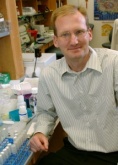
David Cortez, Ph.D.
Associate Professor of Biochemistry
Ph.D., Duke University, 1997 (Molecular Cancer Biology)
Cells respond to genotoxic stress by activating signaling pathways that regulate the cell cycle, DNA repair, transcription, and apoptosis. The ataxia-telangiectasia mutated (ATM) and ATM-and Rad3 related (ATR) protein kinases are at the apex of these pathways. These proteins phosphorylate the checkpoint kinases Chk1 and Chk2 and regulate numerous tumor suppressor proteins including p53 and the breast and ovarian susceptibility protein BRCA1. Studies in this laboratory aim to identify components of these DNA damage response pathways and to understand how they work in a coordinated manner to prevent cancer by regulating the cell cycle, promoting DNA repair, or initiating apoptosis. The long-term goal is to understand how cells preserve genomic integrity and determine the role of genomic instability in tumorigenesis.
https://medschool.vanderbilt.edu/cortez-lab/
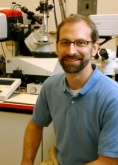
Brandt Eichman, Ph.D.
Professor of Biological Sciences and Biochemistry
Ph.D., Oregon State University, 2000 (Biochemistry & Biophysics)
DNA damage arising from exposure to environmental toxins and cellular metabolites thwarts DNA replication and leads to genome instability, cell death, and diseases including cancer. This laboratory uses the tools of structural biology and biochemistry to investigate molecular mechanisms of proteins involved in repairing DNA damage and maintaining replication fork progression. Current work focuses on base excision repair of DNA alkylation damage by DNA glycosylases, repair of stalled replication forks by structure-specific DNA translocases, and the coordination of DNA unwinding and synthesis during eukaryotic replication. The long-term goals are to understand the fundamental processes underlying genome maintenance and to develop new therapeutic strategies that target genetic diseases.
https://strucbio.vanderbilt.edu/eichman

Martin Egli, Ph.D.
Professor of Biochemistry
Ph.D., Eidgenössische Technische Hochschule Zürich, 1988 (Organic Chemistry)
As an X-ray crystallographer, Prof. Egli is involved in a number of ongoing collaborations to determine how cancer-causing chemicals interact with DNA to produce mutations. He is an expert in the fields of structural and chemical biology. Specifically, he is interested in the three-dimensional structure of DNA and RNA and the design of therapeutics based on that structure, the interactions between DNA polymerases and adducted DNA, and the structure and function of the KaiABC circadian clock from the cyanobacterium S. elongatus.
https://medschool.vanderbilt.edu/biochemistry/person/martin-egli
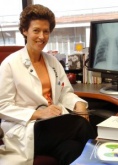
Tina Hartert, M.D., M.P.H.
Associate Professor of Medicine
Director, Center for Asthma and Environmental Health Research
Director, Medical Scholars Program
Director, Vanderbilt Environmental Health Science Scholars Program
M.D., Vanderbilt University, 1990 (Medicine)
M.P.H., Vanderbilt University, 1998 (Public Health)
Prof. Hartert’s large and multidisciplinary research team’s focus is on identifying and understanding how common environmental factors contribute to childhood wheezing illness, asthma development and severity, and how they may be modified to prevent disease. She has established three novel cohorts that form the basis of the current clinical and translational research projects within the Center for Asthma Research, the Shanghai Women’s Asthma and Allergy Study, the Tennessee Asthma Bronchiolitis Study, and the Tennessee Children’s Respiratory Initiative. Work from the Center has contributed to understanding the role of environmental factors in asthma inception and prevention, impacted vaccine policy for persons with asthma, identified the relationship between respiratory viral infection severity in infancy and the illness severity-dependent risk on early childhood asthma development and asthma severity, as well as established the putative causal role of respiratory viral infection in asthma development.
https://medschool.vanderbilt.edu/mph/person/tina-hartert-md-mph

M. Shane Hutson, Ph.D.
Professor of Physics
Director of VPROMPT: Vanderbilt-Pittsburgh Resource for Organotypic Models for Predictive Toxicology
Ph.D., University of Virginia, 2000 (Biophysics)
His research interests are in biological physics and its intersection with developmental toxicology— specifically in how biological development can be probed and manipulated by light (biophotonics), how cellular forces drive tissue morphogenesis (biomechanics), and how embryonic development is disturbed by environmental exposures (systems biology of developmental toxicology). These projects involve both experimental and computational approaches and use either animal model systems (Fruit flies) or advanced organ-on-a-chip technologies.
Research projects include: biomechanics of morphogenesis: integrating the genetics and mechanics of embryonic wound healing: modeling the systems biology of tissue fusion events (urethra, secondary palate); and integrating organs-on-a-chip (early mammary gland, early limb development, fetal membrane and liver) to investigate developmental toxicology.
https://my.vanderbilt.edu/shanehutson/
https://www.vanderbilt.edu/vprompt/
https://www.vanderbilt.edu/vibre/

Lawrence J. Marnett, Ph.D.
Mary Geddes Stahlman Professor of Cancer Research
Professor of Biochemistry and Chemistry
Director of the A.B. Hancock, Jr. Memorial Laboratory for Cancer Research
Director of the Vanderbilt Institute of Chemical Biology
Ph.D., Duke University, 1973 (Chemistry)
This laboratory is interested in the structure, mutagenicity, and repair of adducts derived from lipid oxidation products such as malondialdehyde. Adducts of defined structure are engineered site-specifically into viral DNA molecules that are introduced into bacterial and mammalian cells for evaluation of their mutagenic potential and repair. NMR and X-ray crystallographic experiments are performed in parallel to determine the three-dimensional structure of oligonucleotides bearing the chemical adduct. A second interest in this laboratory is the structure and function of fatty acid oxygenases. Enzymes such as cyclooxygenase (COX) and lipoxygenase catalyze the committed step in the metabolism of polyunsaturated fatty acids to bioactive lipids. Mechanistic studies, affinity labeling, and site-directed mutagenesis experiments are used to define critical amino acid residues and substrate and inhibitor binding sites. Particular attention is being focused on the design and synthesis of novel COX-2 inhibitors that are anti-inflammatory but not ulcerogenic and on the characterization of the chemistry and biology of COX-2-selective substrates.
https://medschool.vanderbilt.edu/marnett-lab/
 Maulik R. Patel, Ph.D.
Maulik R. Patel, Ph.D.
Assistant Professor of Biological Sciences
Assistant Professor of Cell and Developmental Biology
The Patel Lab takes a multi-disciplinary approach to study mitochondria within the evolutionary context of genetic conflict. Although genetic conflict is typically envisioned as occurring between host and a pathogen, it can also occur between genomes in the same cell. Our research focuses on the role of genetic conflict in mitochondrial biology and disease through investigation of mitochondrial interactions with three sources: pathogens, ‘selfish’ mitochondrial DNA, and the nuclear genome. We employ computational methods to infer adaptive evolution and perform comparative phylogenetics. We use genetics, cell biology, biochemistry, and high-throughput genomic approaches to test these evolution-inspired hypotheses.
https://my.vanderbilt.edu/maulikpatellab/
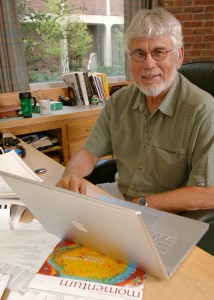
Ned A. Porter, Ph.D.
Stevenson Professor of Chemistry and Professor of Biochemistry
Associate Director, Vanderbilt Institute of Chemical Biology
Ph.D., Harvard University, 1970 (Organic Chemistry)
Research involves free radical chemistry and the chemistry of biological membranes and lipoproteins. The mechanisms of the free radical reactions of natural products, such as lipids and phospholipids, with molecular oxygen are complex and involve initiation, propagation, inhibition, and termination steps. The research is centered on the chemistry of peroxyl free radicals, hydroperoxides, and peroxides, the intermediates and primary products of the free radical chain reaction. Another subject is degradation products of lipid free radical oxidative pathways, including reactive species such as 4-hydroxy-2-nonenal and other small carbonyl fragments. Reaction of lipids in lipoproteins is potentially important in the deposition of arterial plaque, and current studies involve reactions of free radicals in lipoproteins and effects of antioxidants (Vitamins E and C).
http://www.vanderbilt.edu/chemistry/faculty/porter.php

Eric Skaar, Ph.D., MPH
Professor Pathology, Microbiology, Immunology
Vice Chair for Basic Research
Ph.D., Northwestern University, Immunology and Microbial Pathogenesis
MPH, Northwestern University, Epidemiology and Biostatistics
The major focus of my laboratory is the struggle for nutrient metal between bacterial pathogens and their vertebrate hosts. Specifically, we are interested in innate immune components of the inflammatory response that inhibit microbial growth by chelating nutrient metals. My laboratory investigates this topic through a number of major projects that seek to understand (i) nutrient metal acquisition in the vascular pathogens Staphylococcus aureus and Acinetobacter baumannii, (ii) how vertebrate immune proteins chelate nutrient metal during the pathogenesis of bacterial infection, and (iii) the impact of metal chelation and overload on the inflammatory response to infection.
https://medschool.vanderbilt.edu/skaar-lab/
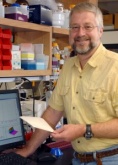
Michael P. Stone, Ph.D.
Professor and Chair of Chemistry and Professor of Biochemistry
Ph.D., University of California, Irvine, 1981 (Biophysical Chemistry)
The research in this lab is aimed at understanding how mutagenic chemicals perturb the structure of DNA and how such perturbations may play a role in mutagenesis. Oligodeoxynucleotides modified at specific sites allow adduct-induced conformational changes in DNA to be characterized in well-defined systems. A variety of optical and magnetic resonance spectroscopy techniques are utilized, with a major emphasis on NMR spectroscopy, to probe the solution conformation and molecular dynamics of modified oligodeoxynucleotides.
https://my.vanderbilt.edu/stonegroup/group-members/
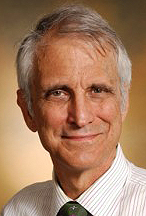
John Wikswo, Ph.D.
Gordon A. Cain University Professor
A. B. Learned Professor of Living State Physics
Director, Vanderbilt Institute for Integrative Biosystems Research and Education
Professor of Biomedical Engineering
Professor of Molecular Physiology and Biophysics
Professor of Physics
The founding Director of the Vanderbilt Institute for Integrative Biosystems Research and Education (VIIBRE), which was created in 2001 with a $5 million, five-year grant from the Vanderbilt Academic Venture Capital Fund to foster and enhance interdisciplinary research in the biophysical sciences, bioengineering, and medicine at Vanderbilt. Within VIIBRE, he has focused on building on-campus collaborations to use microfabrication to create and utilize devices to instrument and control single cells and small collections of cells, and to provide data for parameterization of models of biological processes. He has extensive experience with both industrial/academic collaborations, particularly in both Phase I and Phase II SBIRs, and large DARPA and DTRA projects. Wikswo has been awarded twenty-two patents and has multiple patents pending. He is involved in well-funded organ-on-chip collaborations with the Cleveland Clinic, the University of Pittsburgh, the University of Washington, Johns Hopkins University, and the Baylor College of Medicine.
http://www.vanderbilt.edu/viibre/wikswo.php
Past Preceptors
 T. Alp Ikizler, M.D.
T. Alp Ikizler, M.D.
Catherine McLaughlin Hakim Chair in Vascular Biology
Professor of Medicine
Director, Master of Science in Clinical Investigation Program
Associate Director, DIvision of Nephrology
M.D., Istanbul University Faculty of Medicine, 1987 (Medicine)
T. Alp Ikizler, M.D., is Catherine McLaughlin Hakim Professor of Medicine at the Vanderbilt University School of Medicine (VUSM) in Nashville, Tennessee. He is the Director of Clinical Research in Nephrology and also directs the Master of Science in Clinical Investigation Program at VUSM. The primary research interest of Dr. Ikizler is nutritional and metabolic aspects of kidney disease with a special interest in inflammation and oxidative stress. Along these lines, his research group aims to examine the factors that lead to adverse clinical outcomes in patients with acute and chronic kidney disease, a population with high prevalence of wasting syndrome and at significantly increased hospitalization and death risk with a specific emphasis on nutritional and metabolic aspects. Dr. Ikizler’s earlier studies have focused on how dialysis procedure affects protein metabolism, i.e stimulation of protein degradation and anabolism in muscle and other tissues. Along these lines, they demonstrated that dialysis-stimulated proteolysis is due in part to inflammation and that the defects in protein breakdown can be blunted by giving parenteral or oral nutrition with or without exercise. His group also studies the mechanisms through which metabolic derangements develop in earlier stages of chronic kidney disease and the interplay between progressive loss of kidney function, the associated metabolic abnormalities, and increased cardiovascular risk profile in this patient population. Through numerous collaborations with other prominent investigators, they were able to show the inter-relationships between oxidative stress, inflammation, and endothelial dysfunction in patients with chronic kidney disease. These collaborations have led to ongoing studies testing the effects of antioxidant and anti-inflammatory therapies as well as lifestyle modification interventions on oxidative stress, inflammation, and endothelium dependent vascular function in patients with kidney disease.
https://medschool.vanderbilt.edu/ikizler-lab/
 L. Jackson Roberts II, M.D.
L. Jackson Roberts II, M.D.
Professor of Pharmacology and Medicine
M.D., University of Iowa, 1969 (Medicine)
Free radicals primarily derived from oxygen have been implicated in a wide variety of diseases ranging from atherosclerosis, cancer, neurodegenerative diseases, and the normal aging process. Free radicals readily attack lipids, proteins, and DNA resulting in mutations and deleterious effects on membrane and protein structure and function. Dr. Roberts’ work has involved discovery of a series of novel products termed isoprostanes that result from free radical attack on lipids. Measurement of isoprostanes has emerged as the most reliable approach to assess free radical reactions in vivo. They also exert potent biological activities that are currently being characterized. This work has also uncovered a series of similar compounds neuroprostanes) formed by free radical attack on a docosahexaenoic acid which is enriched lipid in the brain, and the role of these in neurodegenerative diseases is currently under investigation. The Roberts lab and collaborators discovered novel highly reactive gamma-ketoaldehydes that are produced by these pathways. These molecules rapidly adduct to and crosslink proteins, and the Roberts lab is currently exploring the pathobiological consequences of their formation in neurodegenerative and other diseases. They have also discovered new products of lipid peroxidation called isofurans whose formation is uniquely regulated by oxygen tension. Measurement of isofurans provides a unique tool to assess the role of oxidative injury in the setting of hyperoxia and in disorders of mitochondrial dysfunction. This provides ample opportunity for scientific investigation in a multidisciplinary area of research relevant to human disease.
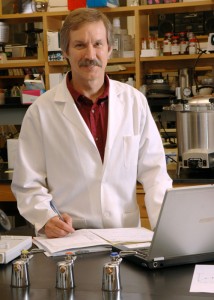 William M. Valentine, Ph.D., D.V.M.
William M. Valentine, Ph.D., D.V.M.
Associate Professor of Pathology
Ph.D., University of Illinois, Chicago, 1983 (Physiology and Biophysics)
D.V.M., University of Illinois, Champaign, 1985 (Veterinary Medicine)
The goal of the research in the Valentine lab is to identify mechanisms of environmental agents that contribute to increased risk for Parkinson’s disease (PD). Researchers in the lab are currently investigating whether four classes of pesticides that have established human exposure can impair ubiquitin based protein processing and cell signaling that promotes neurodegenerative changes contributing to PD. Animal models are being used to determine whether these pesticides inhibit E1 activating enzyme through a common mechanism in vivo leading to nigrostriatal and extra nigral toxicity. These studies are determining the dose-response for changes in brain E1 enzyme activity, characterizing E1 covalent modifications by shotgun LC/MS/MS, and mapping neurodegenerative changes in regions of the central and peripheral nervous systems involved in Parkinson’s disease. In vitro systems are being used to ascertain the cause and effect relationship for ubiquitin pathway inhibition and dopaminergic cell death through determining the influence of constitutively compromised and increased E1 function on viability and the localization and expression of the dopamine transporter and activation of the Cdk5 complex in differentiated dopaminergic cells exposed to either the proposed pesticides, their metabolites, or specific pharmacologic E1 inhibitors. The Valentine lab believes that the mechanistic data and structure activity relationships derived from these studies will assist in the formulation of more informed risk management for the large population exposed to these agents and will facilitate strategies of intervention to decrease the risk of PD and slow the progression of disease in PD patients.
They are also investigating the role of copper dysregulation in neurodegenerative disease. Misfolded copper binding proteins are associated with a number of neurodegenerative diseases including Alzheimer’s disease, Parkinson’s disease, Huntington’s disease, and prion diseases. The Valentine lab uses an animal model for excess copper accumulation to assess the potential of environmental agents to influence the progression of neurodegenerative disease through effects upon these copper binding proteins and oxidative stress in the brain.